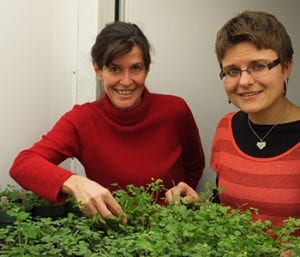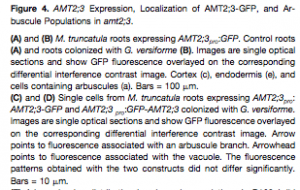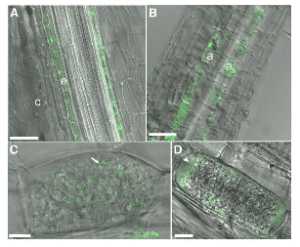News
Ammonium Transporter Saves Plant-Fungal Symbiosis, When Nutrients Run Low
There’s no such thing as a free lunch—for humans or fungi.
A group of soil fungi classified as arbuscular myccorhizal fungi, or AMF, get their sugars from plant roots in exchange for nutrients. But the AMF die off if they are unable to provide nutrients to the plant. A new paper from the laboratory of Professor Maria Harrison identifies the exact protein transporters needed to keep the exchange going by moving phosphate or nitrogen into the plant. They find that while the plant prefers phosphate, under certain conditions, it appears that nitrogen will suffice, and a single transporter is required to tell the plant that it’s getting the goods.
“The best currency is phosphate, but if there’s no phosphate and if the plant is starved for nitrogen, then the transport of nitrogen, potentially in the form of ammonium, is enough to keep things going,” said Harrison.
The paper, “Suppression of Arbuscule Degeneration in Medicago truncatula phosphate transporter4 Mutants Is Dependent on the Ammonium Transporter 2 Family Protein AMT2;3,” appeared April 3 in The Plant Cell.
Using carbon from the plant, AMF form large branching networks to mine the surrounding soil for mineral nutrients. They then penetrate the center of plant roots and transfer the nutrients to the plant through fungal structures called arbuscules. The plant’s transporter proteins take up the nutrients as the final step in this process. Arbuscules live inside the plant cells for about a week before dying off, but are continuously replaced. But, the entire system can shut down if the plant isn’t getting any nutrients from the fungus.
The model plant Medicago truncatula, which the Harrison laboratory uses for their studies, has 13 transporters for phosphate and six for ammonium. In earlier studies, the Harrison laboratory had used mutant plants to show that one phosphate transporter is required to maintain the symbiosis, but when the plant is starved for nitrogen, the fungus flourishes again. This led the researchers to suspect that nitrogen delivery from the fungus to the plant could enable the symbiosis to continue. Alternatively, one of the other phosphate transporters may have taken over.
To test these possibilities and to identify the proteins responsible, they interbred mutant M. truncatula plants that were missing certain phosphate or ammonium transporters to create double- and triple-mutants. By creating plants that lack the necessary proteins to take in the nutrients, they can genetically simulate a shortage of AMF-delivered phosphate or nitrogen. They then grew these mutants with the fungi and looked for evidence of successful AM formation to find the vital transporters.
They identified the one critical ammonium transporter that can keep the symbiosis going, even when the plant doesn’t receive phosphate in return, called AMT2;3. The protein is from the ammonium transporter 2 family and may also serve as the sensor for the plant cell to help it monitor how much ammonium it receives. The researchers hypothesize that without this transporter or the critical phosphate transporters, sugars stops flowing to the fungus and consequently the symbiosis breaks down.
The discovery of the role of this ammonium transporter improves the understanding of how the plant and fungal partners regulate the symbiosis and how phosphate and nitrogen move through the system. These are both important components of fertilizers in agriculture, and in future applications, genes to increase or enhance symbiotic nutrient transport could be bred into plant varieties to create healthier plants with stronger AM symbioses.
“This symbiosis can occur in every major crop for the whole world food supply, not just this little Medicago plant that we use as our model in the lab,” said Harrison. “It works in maize, rice, wheat, sorghum and all the edible legumes.”






